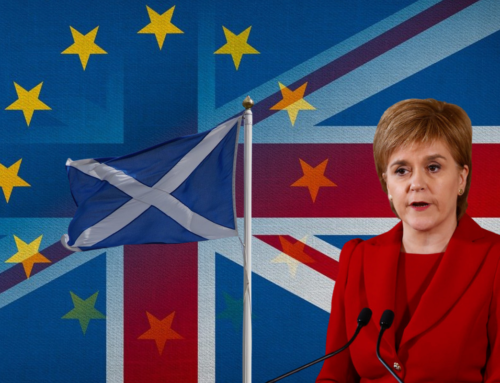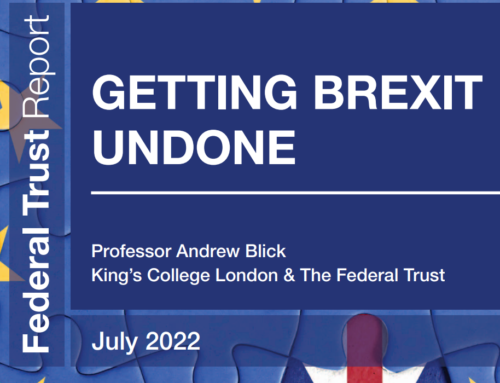BREXIT: THE POLITICAL DECLARATION MUST BE VAGUE AND PRECISE AT THE SAME TIME
by Brendan Donnelly, Director, The Federal Trust
11th October 2018
The issues relating to the status of Northern Ireland after Brexit, and in particular the Irish “backstop,” have not yet been resolved. The major political and administrative challenges confronting the Brexit negotiators in this area are however relatively clear. Assuming that the major economic changes ushered in by Brexit do not take effect until 2021, how can it be ensured that these changes do not create after that date the need for a “hard border” on the island of Ireland that would jeopardise the achievements of the Good Friday Agreement? At the time of writing no answer has been found to this question that will satisfy the British government, the European Union and the Democratic Unionist Party. The terms of the problem needing solution are nevertheless well-established and elements of a possible compromise become daily more sharply defined.
Much more elusive and uncertain is a parallel debate and negotiation occurring in the Brexit talks, that about the Political Declaration that will accompany the Withdrawal Agreement in which the Irish “backstop” will be incorporated. This Political Declaration will supposedly provide significant guidance as to the nature of the economic relationship desired by the EU and UK after Brexit. The Agreement will be a legally precise and binding document, while the Declaration will be more general and aspirational in character. Even so, the Declaration will be far from a formality and widely different conceptions exist of its appropriate style and contents. Although theoretically separate texts, the Agreement and Declaration will be politically and logically linked in a number of respects.
MRS. MAY’S HOPES AND CONSTRAINTS
It is worth recalling that a simple Political Declaration to accompany the Withdrawal Agreement was not the original aspiration of the British government. The British government had hoped in the two years of the Brexit negotiations to agree with the EU a final and definitive arrangement on the future economic relationship, a future economic relationship that would maintain for the UK as much as possible of its current frictionless trade with the EU. This was never a remotely plausible prospect. The EU refused from an early stage to engage in any such discussion before the UK had left the Union in March 2019; two years would in any case have been too short a time to conclude so complicated and wide-ranging a negotiation; and the EU is not going to extend all the benefits of its single market to a country wishing, as does the United Kingdom, to leave the single market. Grudgingly, the British government has acquiesced in this reality, but it has continued to hope that the Political Declaration will be as detailed and politically binding a document as possible, pointing towards a smooth future trading relationship that will obviate among other things the need for a “hard” border in Ireland. As so often in the Brexit negotiations, this British hope will only be capable of very imperfect realisation. The clearer and more specific the Declaration is, the more it is likely to stress the economic losses implicit in Brexit. A clear and specific Declaration is also more likely to emphasise than to reduce the need for the Irish “backstop.”
Two related factors constrain Mrs. May in her approach to the Political Declaration, the need to appease differing groups of mostly Conservative MPs who will later in the year be voting on the package of Withdrawal Agreement and Political Declaration; and the “red lines” she has herself enunciated of her government’s absolute determination after Brexit to put an end to Freedom of Movement and the jurisdiction of the European Court of Justice. Both these considerations make it difficult, perhaps impossible for Mrs. May to agree a Declaration which is vague enough to satisfy a range of MPs and yet precise and encouraging enough to be presented as a negotiating success in defending her “red lines.”
Most Conservative MPs have only a very general idea of the nature of and interconnections between the Withdrawal Agreement and the Political Declaration. They are however aware that at an early stage of the negotiations the United Kingdom agreed to pay its contribution to the European budget until 2020 and beyond, a contribution estimated over time at some 39 billion euros. They have been allowed to believe by Mrs. May’s government that this payment will (or at least should) generate sufficient goodwill on the European side as to result in a favourable trading arrangement for the UK with the European Union after Brexit. It will be an unwelcome shock to them to discover that such is far from being the view of the European Union, which sees these payments as a legal obligation largely unrelated to discussions on future trading arrangements. Mr. Barnier and his colleagues have remained unmoved by British protestations to the contrary.
For the EU, the question of its future trading relationship with the UK is essentially determined by Mrs. May’s “red lines,” the second of her constraints in the Brexit negotiations. The member states of the Union unanimously regard these “red lines” as limiting the scope and depth of the EU’s future trading relationship with the UK. It may be that in the final negotiations on this trading relationship differences of emphasis emerge between the member states on the extent of these limits. But at the moment the general principle of “no cherry-picking” is uncontroversial within the EU27. The EU27 may be prepared not to emphasise this reality in the Political Declaration in order to help Mrs. May, but they will not be prepared to deny it, for instance by endorsing the Chequers proposals. If the EU27 are to move in the direction of greater specificity in the Political Declaration it will not be towards Mrs. May’s preferred outcomes. It will be away from them. The more precise the Political Declaration, the less it will satisfy Mrs. May and those Conservative MPs hoping to see a quick and profitable return on what they regard as their investment of 39 billion euros. The intractability of Mrs. May’s dilemma is underlined by the fact that a vague Political Declaration will be equally disappointing to this particular Parliamentary audience. But Mrs. May’s problems do not stop there.
THE DECLARATION IN THE COMMONS
A well-organised and highly motivated minority of Conservative MPs, notably the European Research Group(ERG), have begun recently to find attraction in the possibility of a Political Declaration that precisely envisages a more distant and less intimate future trading relationship between the UK and the EU. They find themselves in an unexpected partial congruence of view with Michel Barnier, who has been tireless in stressing the limitations placed on the future relationship by Mrs. May’s red lines. The ERG welcomes these limitations and is eager to see them emphasised in the Political Declaration. They fear above all an imprecise Declaration which may then be used by Mrs. May and the EU as a launching-pad for a continuing close relationship with the EU as the negotiations of the “transition period” unfold. Many members of the ERG favour an eventual Free Trade Agreement (FTA) with the EU along the lines of that enjoyed by Canada. They hope to persuade Mrs. May that a commitment to this goal should be contained in the finally adopted Declaration. For the moment, Mrs. May still nourishes the hope that the Chequers proposals, publicly rejected by the ERG and much of the Conservative Party, will form the basis of the Political Declaration. She believes, perhaps correctly, that these proposals are acceptable to a majority of Conservative MPs. Unfortunately, they are in many of their most important elements unacceptable to the EU.
If the ERG’s preferred outcome of a Canada-style arrangement were to be reflected in the Political Declaration, Mrs. May would definitively alienate from her party an important segment of its traditional support in the financial and business communities. These traditional supporters have only acquiesced in Mrs. May’s negotiating tactics in the expectation that she would avoid at the end of the negotiations the “hard Brexit” a Canada-style relationship would imply. Mrs. May might well also lose the support of an as yet unspecified number of Conservative MPs favouring a less disruptive form of Brexit. Most importantly, an FTA with the EU mimicking that enjoyed by Canada, would make, in the view of the EU and the Irish government, a “hard border” on the island of Ireland all but inevitable. The negotiation of the Irish “backstop” would become significantly more difficult, a difficulty in no way mitigated by the insistence of some in the ERG that the supposed difficulties of the Irish border can be solved by technology. This is simply not believed anywhere other than in Central London.
NO WAY OUT?
There is obviously no good answer to the layers of conundrum that Mrs. May faces in regard to the Political Declaration. It may well be true that an imprecise and woolly Political Declaration would give her the best chance of constructing a heterogeneous majority in the House of Commons for the “meaningful vote” promised on the result of the Brexit negotiations in the coming months. To agree a Declaration with the EU containing a sufficient degree of vagueness as to reconcile differing approaches within the Commons would not be easy, but is perhaps achievable. A recent and powerful slogan has however recently entered the Brexit lexicon, that of a “blind Brexit.” If her Political Declaration is as nearly vacuous as it would probably need to be to command a heterogeneous majority in the House of Commons, it will expose the Prime Minister to plausible accusations of indecisiveness and drift. In particular, the Labour Party will find it easy to vote against anything describable as a “blind Brexit,” as not meeting the Party’s tests for an acceptable Brexit.
When West Germany was rearmed after the Second World War, it was said that France was looking to create a German army smaller than the French army, but larger than the Red Army. Mrs. May finds herself in a similar logical trap concerning the Political Declaration that will supposedly conclude the Brexit negotiations. A vague Political Declaration will alienate those MPs hoping that the UK would by now have been well on the way to negotiating a favourable future trading relationship with the EU. A more specific Declaration will make clear how delusory any such hope is, given Mrs. May’s “red lines.” If moreover the Declaration is to satisfy the ERG and most of the rest of the Conservative Party outside Westminster, it will alienate important British economic actors and make the resolution of the Irish backstop difficult to the point of impossibility.
The Political Declaration is yet another aspect of Brexit where the British government has no good options to contemplate, but only a range of options unattractive in different ways. The paradoxes inherent in finding an acceptable formulation for the Declaration are a reminder of the radically different expectations with which different electors voted for Brexit in June 2016. If there is a Political Declaration agreed in the coming weeks, its content will inevitably provide useful rhetorical material for those advocating a “People’s Vote.” Any vacuous Declaration will be stigmatised as leading to a “blind Brexit.” A more precise Declaration, highlighting the unavoidable negative consequences of Brexit, will clearly not represent what an important section of the Leave-voting electorate thought they were voting for in 2016. The Prime Minister may well end up strangled by this Gordian knot, to the tying of which she has contributed much by her own choices.








[…] Todays User Suggested Website:From time to time our members recommend websites of interest to them. Please visit: http://fedtrust.co.uk/brexit-the-political-declaration/ […]
[…] Source: BREXIT: The Political Declaration | The Federal Trust […]